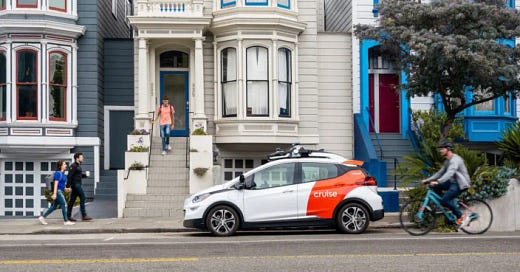Heya friends, happy Friday!
Weird fluke from last week, where my newsletter was sent out twice by Substack. On the one hand, thank you for the record readership (lol) and on the other🤞it doesn’t happen again! In addition, lots of warm responses to last week’s nerd session on the London Zoo and Harry Styles. I’ll see if I can’t pepper in more pop-culture references for future editions :).
Alright, one last note before we dive in: I’ll be in Vancouver the week of May 2nd! If you’re around and want to walk + talk + drink tea + photosynthesize in the spring sun, shoot me a response to this newsletter 🌞
Ok, onto le news:
Government and Policy
What happens when police try to pull over an AV?
There was … a lot of news this week about a San Francisco cop pulling over one of Cruise’s AVs (it was operating without headlights), only to realize there was no driver to be found. The vehicle stops, before driving through an intersection away from the cop. Cruise noted that the vehicle had behaved as expected “by moving to a safer location on the other side of the intersection where police were able to address their concerns”.
More takes in the San Francisco Examiner and The Guardian.
When a city becomes a test lab
San Francisco examiner has a piece out this week about how the city became a living laboratory for Silicon Valley’s best worst and brightest bullish automotive tech companies. The vehicles are still a mystery to most of the public, and yet in San Francisco they are more common than your traditional taxi cab.
The science behind reckless driving
What makes a bad driver? While we know it’s bad infrastructure, there is something to be said about individual character traits too. Scientists have long struggled to find a distinct personality trait shared among risky drivers, but by analyzing saliva they may have found a pattern to follow (I too was surprised to be reading about saliva in my transport news, but here we are!!).
“The participants in the three groups of risky drivers all had one distinction from the control group — their cortisol levels were lower during the stress test.. Scientists call a lower cortisol stress response (CSR) “blunted,” meaning the person doesn’t show a significant response to a stressful activity.”
Industry
Tesla developing a vehicle for shared rides
Tesla has (once again) confirmed they are working on an autonomous vehicle / shuttle to transport larger groups of people at once. Musk himself shared a render of a van at the opening of the Texas Giga Factory. The van render has a tall body with wide windows, sliding doors, front and side seats, and no driver controls. It has bulging fenders that house its wheels, and is reminiscent of the people-mover train cars used at several airports and event centers.
Welp, it’s my worst nightmare realized. If we’re going to go to space, might as well bring our best solutions, not our sticky, wicked problems. Right? Right. Anyways, NASA held an open procurement for space cars (can’t make this shit up), and they’ve selected a company to make “lunar vehicles”. I know these aren’t for mass mobility, but I am still dismayed / disheartened / distressed. Please send tea.
The more you know:
Bosch acquire’s Five.ai (TechCrunch)
ArgoAI is coming to Greenville County (Governor)
Research and Academia
On travel behaviour and disability
“While people with disabilities have different travel patterns compared with the general traveller population, such discrepancies are ignored in mainstream travel demand modelling and planning practice. The failure to represent the diverse travel behaviour of people with disabilities leads to inaccurate forecasting and poor decision-making and exacerbates transportation disadvantages. Thus, this systematic review synthesises previous studies of travel behaviours among people with disabilities, differing from people without disabilities, in terms of trip frequency, mode choice, travel time and distance, and barriers.”
Geographies of street space allocation
“The allocation of street space involves a range of governance, political and ethical considerations, yet efforts to reallocate street space should also be informed by empirical evidence of street space allocation and use. This can help to ensure that street space is distributed more equitably to users and support broader goals for increasing the uptake of more sustainable forms of transport. Using a case study of Melbourne's activity centres, this research aimed to understand how much street space is allocated and used by each mode of transport. It also explored factors that are associated with the use of each mode of transport.”
Opinion
Cause and effect of congestion
One of my favourite reads this week, this article breaks down the concept of congestion brick by brick. Well worth the read / time for the wonks out there.
“But the public is just as guilty of contributing to the frustrations of congestion as the field of planning. Despite its consistent, direct impact on the experiences of people living in almost every developed corner of the world, congestion is still widely misunderstood by the public, heavily debated by leading scientists, and co-opted for loosely connected purposes by politicians and culture warriors. The expectation that planners might solve congestion with so many misconceptions and so much misunderstanding, cultural politics, and pseudoscience swirling around the issue is unfair to a certain extent.”
That’s all from me. Have a beautiful weekend folks.
Sarah




